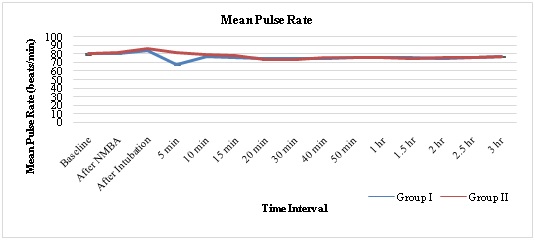Intubating conditions, onset, duration and side effects with rocuronium and atracurium: A comparative
Abstract
Objective(s): To compare the intubating conditions, onset and duration of action, side effects and complications with rocuronium bromide and atracurium besylate.
Material and Method: This prospective, randomized double blind study was conducted with a sample size of 100 patients. After standard general anaesthesia technique group I received IV. rocuronium bromide 0.6 mg/kg and group II received iv. atracurium besylate 0.5 mg/kg. Laryngoscopy was attempted60 sec after administration of NMBA and thereafter every 30 sec till good or excellent intubating conditions were achieved. Intubating condition was scored on fourpoint scale (0-3). Intubating conditions, onset and duration, side effects and complications were observed and recorded.
Result: Overall intubating condition was acceptable (excellent + good) in 50(100%) patients in group I and 47(94%) patients in group II. It was excellent in 45(90%) and 16(32%) patients in group I and II respectively. Good intubating condition was found in 5(10%) and 31(62%) patients in group I and II respectively. Fair intubating condition was found in 3(6%) patients in group II. None of the patients had poor intubating condition in either group. Cutaneous flushing was found in 4% cases in group II. No other side effects and complications were observed.
Conclusion: Rocuronium with its faster initial response and possibly early laryngeal muscle paralysis provides better intubating conditions in shorter duration of time than atracurium.
Downloads
References
Fuchs-Buder T. and Tassonyi E. Intubating conditions and time course of rocuronium-induced neuromuscular block in children. Br J Anaesth. 1996;77:335-38.
Savarese JJ. and Kitz RJ. Does clinical anesthesia need new neuromuscular blocking agents? Anesthesiology 1975;42 (3):236-39.
Stoelting R.K. Neuromuscular blocking drugs pharmacology and physiology in Anaesthetic practice. Lippincott Raven USA 3rd Edition, 1999;182-23.
Cooper R., Mirakhur R. K., Clarke R. S. J.and Boules Z. Comparison of intubating conditions after administration of ORG 9426 (rocuronuium) and suxamethonium. Br. J. Anaesth. 1992;69:269-73.
Payne JP, Hughes R. Evaluation of atracurium in anaesthetized man. Br J Anaesth. 1981 Jan;53(1):45-54.
Darshna D Patel and Varsha N Swadia. Rocuronium bromide versus vecuronium bromide: Comparison of onset, intubatimg condition and duration of action. Int J Res Med. 2013;2(2):137-41.
ElbradieSamia. Neuromuscular efficacy and histamine release hemodynamic changes produced by rocuronium vs atracurium: A comparative study. Journal of Egyptian Nat. cancer Inst. 2004;16:107-13.
Whalley DG, Maurer WG, Knapik AL, et al. Comparison of neuromuscular effects, efficacy and safety of rocuronium and atracurium in ambulatory anaesthesia. Can J Anaesth. 1998 Oct;45(10):954-9. DOI: https://doi.org/10.1007/BF03012303.
Mirakhur RK, Lavery GG, Clarke RS, et al. Atracurium in clinical anaesthesia: effect of dosage on onset, duration and conditions for tracheal intubation. Anaesthesia. 1985 Aug;40(8):801-5.
Bunburaphong P., Werawataganon T and Panyarachun K. Intubating conditions after three different doses of rocuronium in elderly. Can J. Anaesth.1998; 45(10): 954-9.
Plaud B, Proost JH, Wierda JM, et al. Pharmacokinetics and pharmacodynamics of rocuronium at the vocal cords and the adductor pollicis in humans. Clin PharmacolTher. 1995 Aug;58(2):185-91. DOI: https://doi.org/10.1016/0009-9236(95)90196-5.
Pühringer FK, Sparr HJ, Mitterschiffthaler G, et al. Extended duration of action of rocuronium in postpartum patients. AnesthAnalg. 1997 Feb;84(2):352-4.
Saxena, A.H. Rocuronium bromide: a clinical trial. J. Anaesth. Clin. Pharmacol. 1999 Apr.;15(2):183-85.
Singh Ajeet and Bhatia Pradeep Kumar. Comparision of onset time, duration of action and intubating conditions with suxamethonium and rocuronium. Indian. J. Anaesth.2004;48(2):129-33.
Meistelman Claude, Plaude B. andDonati F. Rocuronium (ORG 9426) neuromuscular blockade at the adductor muscles of larynx and adductor pollicis in humans. Can I. Anaesth.1992 Sep;39(7):665-69.
Khuenl-Brady KS, Pomaroli A, Pühringer F, et al. The use of rocuronium (ORG 9426) in patients with chronic renal failure. Anaesthesia. 1993 Oct;48(10):873-5.
Sehgal Arun, Sharma R.K. and Kumar Indrani. Comparison of intubating conditions and time course action of Rocuronium Bromide and Vecuronium Bromide. Ind. J. Anaesth.2001;45(4):255-58.
Awasthi S.N., Swe K.K. and Kyi D.W. Initial clinical experience with atracurium. Ind J. Anaesth.1987;35(2):128-32.
Bharti Neeraja, Sharma Sunil, Goel S.K. and Deepak Falgune. Rocuronium: Time course of action and intubation conditions, - A comparison with atracurium and vecuronium. Indian J. Anaesth.2001;45(5):363.
Wierda JM, de Wit AP, Kuizenga K, et al. Clinical observations on the neuromuscular blocking action of Org 9426, a new steroidal non-depolarizing agent. Br J Anaesth. 1990 Apr;64(4):521-3.



 OAI - Open Archives Initiative
OAI - Open Archives Initiative


